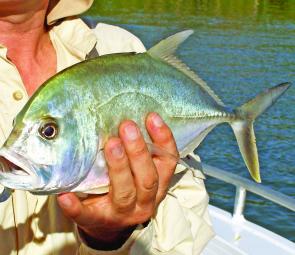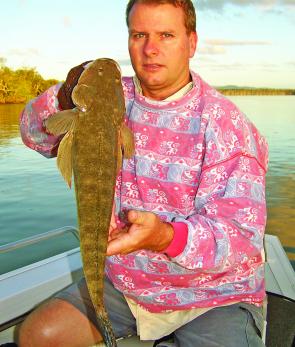Very ordinary weather has severely limited offshore options recently, but anglers who have been ready to use the limited windows of opportunity have been well rewarded.
At last good numbers of mackerel have arrived. Rather late, but at least they are here! Hopefully this means they will hang around for longer than usual so that those of us who haven’t had the chance to get out there and get into them get the chance. Jew Shoal and Sunshine Reef have been the best areas up to early April. North Reef has seen a few mackerel and some quality yellowfin tuna as well.
Trolling large minnow lures, particularly in chrome so that shards of light flash in all directions as the lure shimmies its way through the water, generally results in a feed of mackerel by days end. Lures need to be well built with strong hooks and rings or the more serious fish will quickly expose any weaknesses. The last thing you need is for a lure to fall apart or a hook to straighten when a 20kg Spaniard climbs all over it.
A fine wire leader may reduce the number of strikes, particularly in clear water, but bite-offs will be minimal. Heavy mono leader has its place but toothy critters like mackerel will cut through it effortlessly if the strike is mistimed or if it is a monster fish that can swallow the entire lure.
If a couple of hours pass without any hook-ups it may be worth employing a couple of high-speed bibless lures in an attempt to save the day. A few extra knots and a high-speed shimmy should deliver the goods. Of course, cubing is another great way to get into the action and a good steady trail will eventually bring the fish to the boat.
It is also worth having a solid spin stick at the ready with a chrome slug attached. Should you come across an actively feeding school of mackerel or tuna a slug of similar proportions to the baitfish will sometimes result in a hook-up on the first cast and many subsequent hook-ups! Try and drift into the school with the motor cut in an attempt to not spook the fish. Blasting in at full noise will inevitably sound the school and decrease your chances of success. It will also frustrate other anglers in the area. Trolling through a feeding school or in between anglers casting at feeding fish and their targets are also sure-fire ways to irritate other anglers. If there are other boats in the area keep your distance if on the troll. There are always fish away from the main school and these will often be deep – perfect targets for keen trollers!
Bottom bashers have been enjoying good fishing as well recently. Quality coral trout have been frequent catches, particularly at Sunshine Reef. Those fishing with live baits in 40-45m have tangled with serious cobia on most reefs. Sweetlip to 4kg, small snapper and a few pearl perch and Moses perch complete the picture.
The river is also fishing well as the water starts to cool somewhat. I enjoyed a brief early morning session recently with Lance McFayden in his exceptional Hornet Trophy. With busy days ahead of us we were time challenged and met at the ramp early to put in a couple of hours. The tides weren’t particularly good with water at dead low as we set off and slowly starting to make as the sun came up.
Lance has become a regular on the Noosa River and is fast becoming a skilled angler. Local knowledge is not something that you can pick up overnight. Time on the water, experimentation and perseverance are the only ways to learn a system and this bloke is piecing together the information he collects on each trip very nicely.
Anyway, we headed upstream and started to cast soft plastics about in the hope of a flathead or two. For the first time in my life I left a boat ramp with a box of plastics only. Not a hard-body to be seen, apart from a couple of poppers I had sneaked on board ‘just in case’.
Lance soon hooked a very respectable 60cm+ flathead. Storm plastics were his lure of choice – they had worked well for him in the past and once again they did the trick. Areas that we had both caught flathead in on previous trips failed to deliver, probably due to the slowly incoming tide. We have both found that the run-out is far more productive, particularly for flatties.
A move or two and plenty of prospecting soon saw a bend in my rod, this time to a small jewie – the first for me on a lure. Lance completed the session with a trevally and we both missed a few hits in the last area we tried – almost certainly more trevors.
The lower reaches of the river have been delivering quality whiting, particularly near the river mouth. Trevally and tailor have been keen at dawn in the Woods Bay area and mangrove jack have been turning up regularly on live bait and lures in between the lakes.
Reads: 1200
Trevally are keen at present, particularly at dawn.

A happy crew after an excellent session chasing mackerel aboard Trekka.

Lance McFayden with a quality Noosa River flathead taken on a soft plastic bounced along the bottom.




